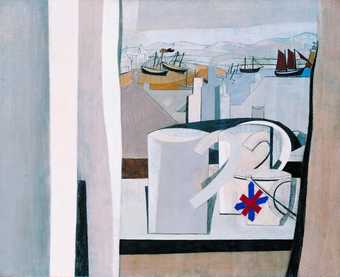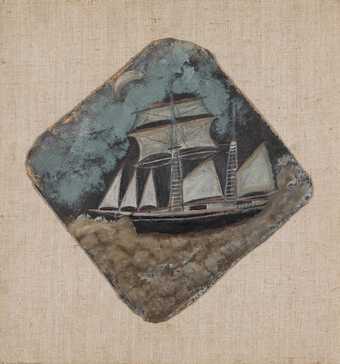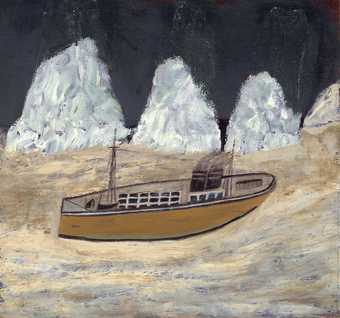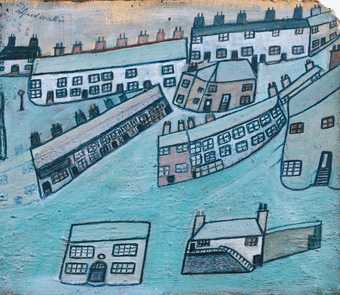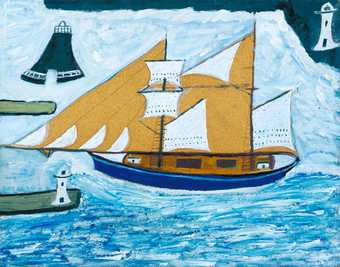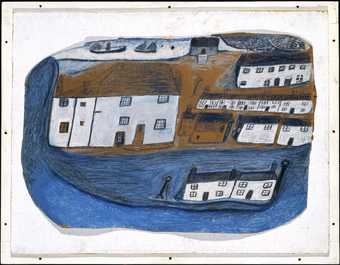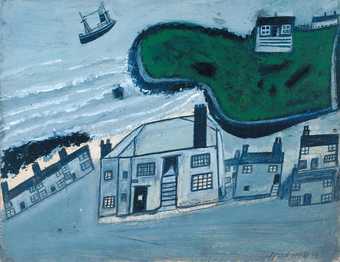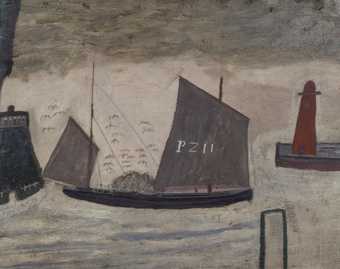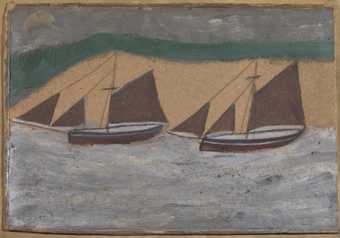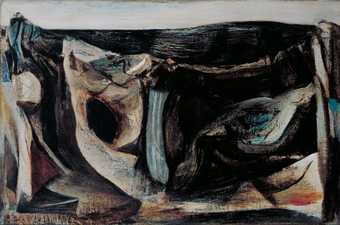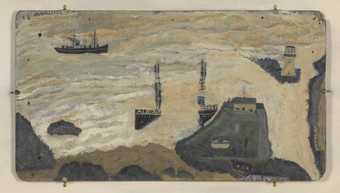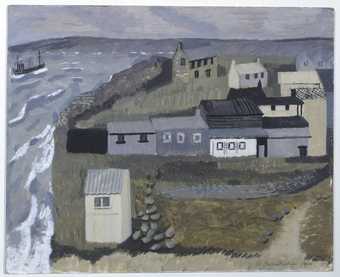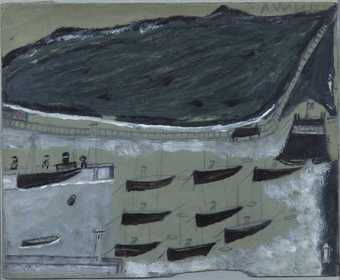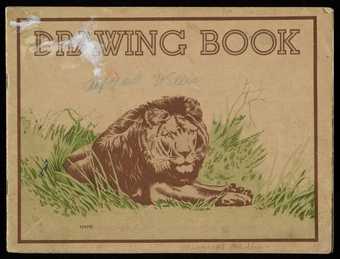
Not on display
- Artist
- Alfred Wallis 1855–1942
- Medium
- Oil paint and graphite on paper
- Dimensions
- Support: 302 × 591 mm
- Collection
- Tate
- Acquisition
- Bequeathed by Mrs Doris Sealy 1975
- Reference
- T01967
Display caption
Wallis, a retired seaman, took up painting in the mid-1920s to relieve the loneliness he felt after the death of his wife. His subjects were based on memories of life at sea and the town and harbour of St. Ives, Cornwall. He painted child-like images on a variety of discarded materials using household or ship's paint. This gave his work a roughness and directness that artists such as Ben Nicholson and Christopher Wood found appealing. 'Two-Masted Ship', for example, is painted on the reverse of a G.W.R. cheap fare schedule for 1928. The ship is a brigantine, many of which were used as trading vessels in the latter half of the nineteenth century until 1920. The lighthouse is probably the Eddystone, off Plymouth.
Gallery label, September 2004
Does this text contain inaccurate information or language that you feel we should improve or change? We would like to hear from you.
Catalogue entry
T01967 TWO-MASTED SHIP c.1928
Not inscribed
Household paint on paper, 12×23 1/4 (20.4×59)
Bequeathed by Mrs Doris Sealy 1975
In a letter of 3 August 1970 to the Director of the Tate Gallery, Mrs Colin Sealy stated that these four paintings depicting fishing vessels off the Cornish coast were all ‘early works bought by my late husband off Wallis in 1928 and they have never been seen or shown’. She added ‘They are not the best Wallises I've seen. Kit Wood and Ben Nicholson discovered him a few days before my husband so that he (Wallis) had not got very many left’.
The following entries-on T01967, T01968, T01969, T01970-were compiled with the assistance of the National Maritime Museum, Miss Margaret Mellis, Terry Frost and Denis Mitchell.
The two-masted ship is a brigantine, a great number of which were engaged in the fruit trade from the Azores to the Mediterranean, the Newfoundland dried fish trade, and the general deepwater and coastal trades from the latter half of the 19th century until 1920. Together with the schooner they formed the bulk of Britain's small merchant sailing vessels at this time and would naturally feature in Wallis's memories of his seafaring days. The lighthouse is probably the Eddystone, off Plymouth.
Wallis's picture is painted on the reverse of a G. W. R. cheap fare schedule for 1928. Inspection of the work revealed, attached to the backing, a chalk drawing of a nude signed ‘Colin Sealy '28’. Margaret Mellis comments: ‘People often paid Wallis with old exercise books, bits of board, cardboard, and occasionally old canvases. Then Wallis painted on the back-or sometimes on the front’.
Published in:
The Tate Gallery 1974-6: Illustrated Catalogue of Acquisitions, London 1978
Explore
- architecture(30,960)
-
- public and municipal(2,385)
-
- lighthouse(333)
- UK counties(19,585)
-
- Cornwall(1,034)
- England(19,202)
- England, South West(3,507)
- England, Southern(8,982)
- transport: water(8,015)
-
- ship, sailing(1,342)
You might like
-
Ben Nicholson OM 1943-45 (St Ives, Cornwall)
1943–5 -
Alfred Wallis Schooner under the Moon
?c.1935–6 -
Alfred Wallis Voyage to Labrador
?c.1935–6 -
Alfred Wallis Houses at St Ives, Cornwall
?c.1928–1933 -
Alfred Wallis The Blue Ship
?c.1934 -
Alfred Wallis St Ives
c.1928 -
Alfred Wallis ‘The Hold House Port Mear Square Island Port Mear Beach’
?c.1932 -
Alfred Wallis String of Boats
c.1928 -
Alfred Wallis P.Z. 11
c.1928 -
Alfred Wallis Two Boats
c.1928 -
Peter Lanyon Headland
1948 -
Alfred Wallis Wreck of the Alba
c.1938–9 -
Wilhelmina Barns-Graham Island Sheds, St Ives No. 1
1940 -
Alfred Wallis Boats at Rest in Mount’s Bay
date not known -
Alfred Wallis Lion Book
c.1941–2

